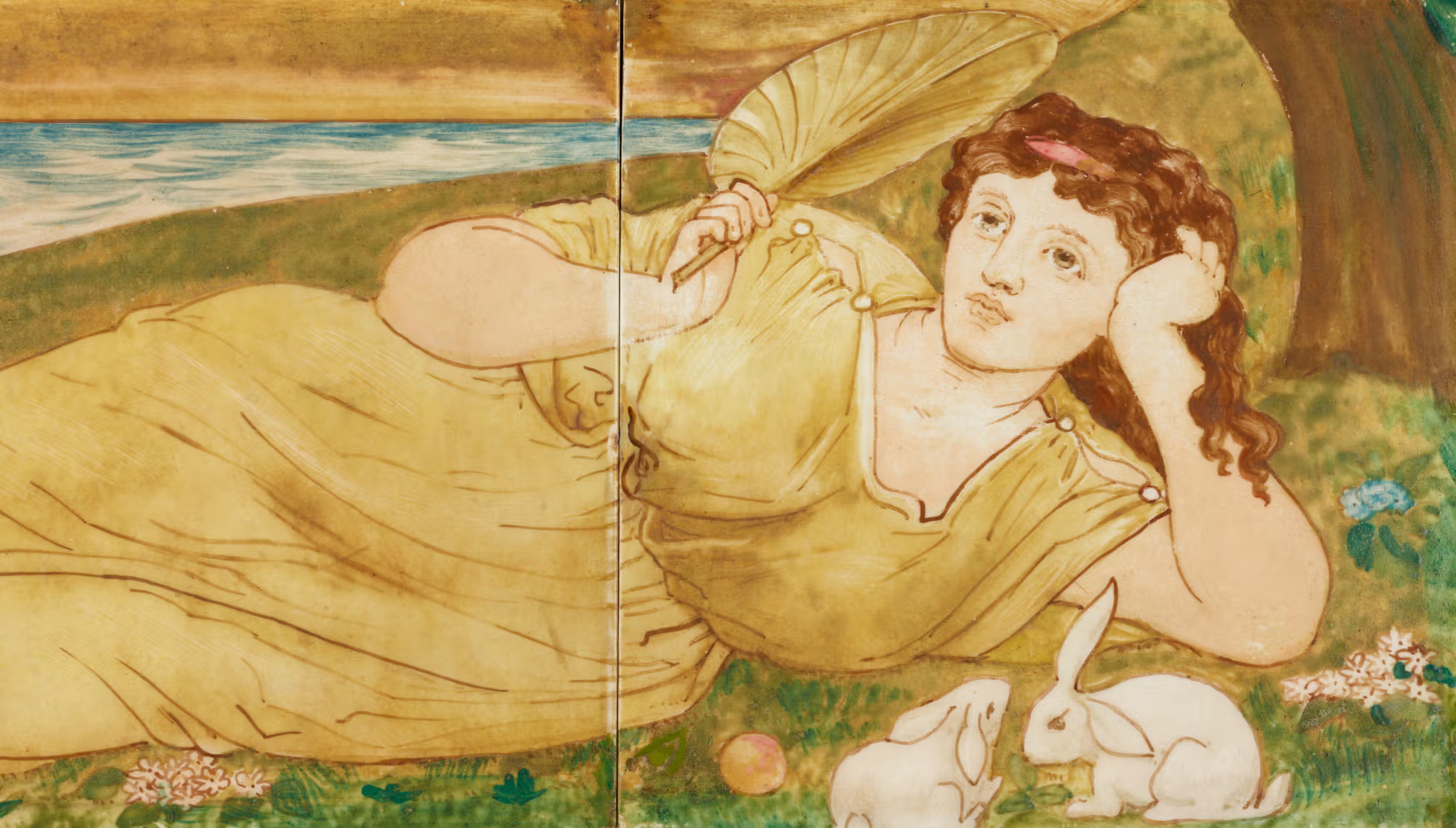A global design story
Their original owner and use remain a mystery, but these striking tiles hold an intriguing connection to a significant international design story.
A set of three handpainted ceramic tiles in the Caroline Simpson Library, each 6 inches square, depicts a young woman reclining in a field. With her flowing red hair, classical features, and winsome, even nonchalant, manner, she could be a figure in a painting by English artist Dante Gabriel Rossetti, who co-founded the Pre‑Raphaelite Brotherhood in the mid-19th century. Yet the tiles were painted a world away, here in Sydney, around 1878 by a firm of painter-decorators, Lyon, Cottier & Co. The tiles bear the maker’s name but no clue to exactly how and where they might have been used. Recent research in a new book, Daniel Cottier: designer, decorator, dealer, has revealed that very similar depictions of reclining figures appear internationally among the work of the Sydney firm’s parent company, Cottier & Co.
From Glasgow to the world
Daniel Cottier established Cottier & Co in London in 1869. Four years later, he opened branches in both New York and Sydney. The latter, launched with his friend John Lamb Lyon, was called Lyon, Cottier & Co. Both men had been born and raised in Glasgow and were ambitious businessmen and decorators. Lyon ran the business in Sydney but imported some designs from Cottier’s London studio and employed a few of Cottier’s talented artisans.
Lyon, Cottier & Co decorated the finest public buildings, private houses and churches in Sydney and Melbourne (where a branch was established in 1887) for around 50 years. The firm was most noted for painted wall and ceiling decorations, including ceramic tiles; the design and manufacture of stained glass; and importing and supplying textiles, carpets and lighting. In London and New York, Cottier & Co also manufactured furniture and dealt in antiques as well as contemporary and old master paintings.
Coordinated interiors
Cottier & Co was one of a new generation of firms that provided coordinated interior schemes rather than offering just one type of furnishing or fitting. And its focus was on creating quality crafted and manufactured wares known as ‘art furnishings’, which went beyond ordinary trade wares and were good enough to please the eye of an artist.
Although the work of Lyon, Cottier & Co sometimes incorporated Australian motifs such as local flora and fauna, many of their designs followed the style of the British parent company. Themes evident in Cottier & Co’s work across three continents draw on art movements of the time, particularly when portraying subjects such as the four seasons, Roman goddesses, literary or artistic figures, and panels of birds, foliage, fruit and flowers.
A recurring image
The depiction of the reclining woman in the Lyon, Cottier & Co painted tiles wasn’t a one-off design but appears in sometimes modified form in various media both in Australia and in Cottier & Co’s work overseas. Probably the first instance of the reclining woman, but facing the opposite direction, occurs in fireplace tiles installed around 1873 in the dining room at the grand Cairndhu House in Helensburgh, Scotland. The same figure also appears in stained-glass designs in both Sydney and London, and an almost identical depiction occurs in a painted panel embedded in a piece of cabinet furniture in the United Kingdom. In addition, the reclining woman was adapted, showing just head and shoulders and holding a fan, to represent summer in images of the four seasons that appear in stained glass and painted decoration, including on the drawing room ceiling at Government House, Sydney.
The recurring motif of the reclining woman in the work of Cottier & Co demonstrates the company’s global reach in the 19th century. Far from being a distant outpost, Sydney was part of an international network that united business with the arts in the form of art manufactures.
Even before establishing his company, Daniel Cottier said: Surely, then, there is in commerce nothing incompatible with art.1
Since few of Cottier & Co’s business records survive, the physical evidence of the company’s work, including these handpainted tiles, provides a small but poignant reminder of the remarkable ambitions and workmanship of this multinational firm.
Footnotes
1. Quoted in Petra ten-Doesschate Chu and Max Donnelly, with Andrew Montana and Suzanne Veldink, Daniel Cottier: designer, decorator, dealer, Paul Mellon Centre for Studies in British Art, London, 2021, p13.
Published on
Related

Past exhibition
Lyon, Cottier & Co: 19th Century Decorators
For around fifty years, Lyon, Cottier & Co decorated the finest public buildings, private houses and churches
